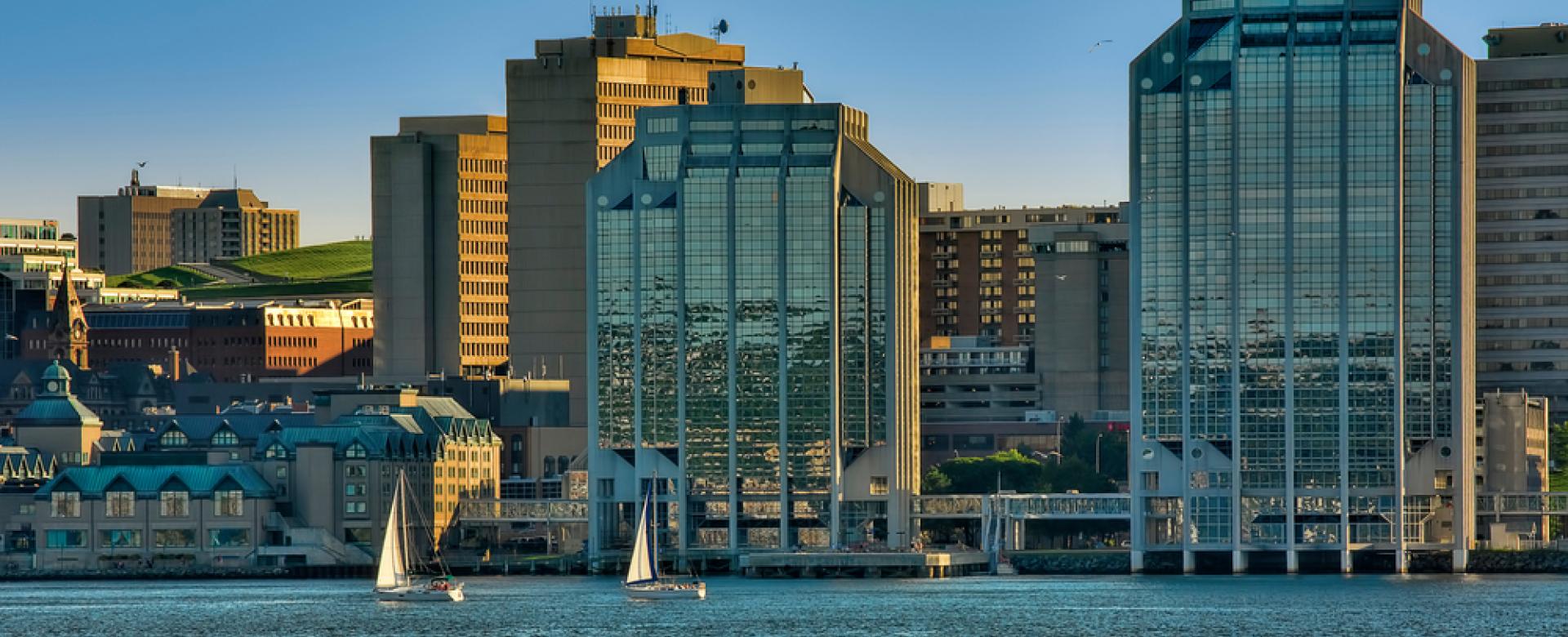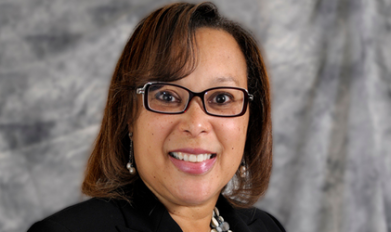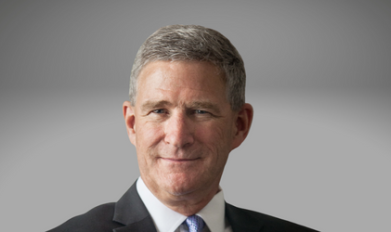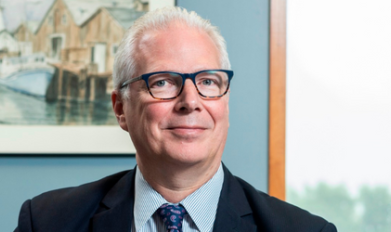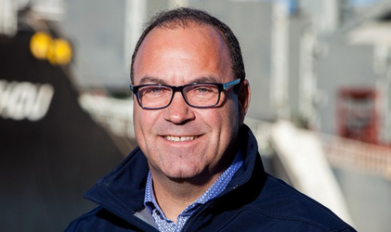Andrea Forbes-Hurley interviews Joyce Carter, the President and CEO of Halifax International Airport Authority (HIAA) to gain insights on how high-impact Atlantic Canadian organizations are optimizing the potential of people to contribute to the region’s growth and prosperity and discuss how strengthening our workforce can enhance our economic outlook.
As the CEO of the organization that manages Halifax Stanfield International Airport, Carter is drawing on nearly 20 years of experience with HIAA to generate economic growth by connecting the region to the world. She speaks about how geopolitical shifts are opening new export opportunities for our organizations, how technology will eventually make security checks seamless and nearly invisible for travellers, and how more diversity in our workforce will help address demographic shifts in our region.
Q: As the airport’s CEO, you have a unique understanding of the shifts in traffic to and from the region. With a record number of passengers served in 2018, what have been some of the most significant economic shifts and trends you have observed that have contributed to that growth?
A: The one thing I have noticed is how economic performance influences these shifts in travel patterns. Travel is often considered optional, particularly during an economic downturn. You can always arrange a business meeting by phone or postpone a family visit. But when the economy is doing well, travel is one of the first industries to rebound, and when that happens, it translates into more employment and more business for us as an airport.
The growth that we experienced last year has made it easier to pursue the growth strategy we launched a few years ago for our airport. Traditionally, we have been an Atlantic Canadian hub and our goal is to become a connecting hub to and from Europe, and the United States. We are starting to see that take off, having added additional flights last year to Paris and Gatwick, London, with WestJet. This year, we have added more frequency to Frankfurt, Germany with Condor, new non-stop flights to Dublin with WestJet, London, Ontario with Swoop, and Chicago with United Airlines. We are also welcoming the return of American Airlines with service to Philadelphia and New York La Guardia.
Many of the passengers on those flights will be connecting from other Canadian and American centres, and that will result in real benefits for our region. For example, a Calgary to Paris flight that connects here not only offers Nova Scotians an additional Calgary flight but also creates opportunities for us to partner with Tourism Nova Scotia on promotional campaigns that grow inbound tourism for the province and the region from that originating market.
In that way, I see us as a facilitator – an enabler that helps the province deliver on its goals of increased tourism, trade, and immigration as set out in Now or Never: An Urgent Call to Action for Nova Scotians.
Q: Given that economic growth has led to new flights and increased demand for passenger service, has there also been a shift in terms of commercial transport or cargo activity?
A: There has been. Last year alone, the growth in tonnage was 8.5 per cent and we are looking to build on that. Cargo development has become one of our four strategic priorities, not necessarily as a means of driving airport authority profitability but rather to help the province reach its goal of increasing exports by 50% by 2024. That has led to several cargo-related initiatives, such as the extension of our main runway, which was completed in 2013, and the construction of our first cargo facility back in 2010. We now have approximately six fully dedicated freighter flights a week, and our analysis suggests the economic impact of each flight is approximately $1.5M for the province and our region, and the equivalent of 16 full-time jobs.
This is an area where we believe we can have a major impact on economic growth. More freighter flights mean our region’s high-quality fish products can get to market much faster than using truck transportation. That will lead to significantly reduced mortality rates and ensure our fisheries industry can command the highest possible prices for its products. We want to further that export activity, but to do that, we need to expand. We have received funding from the federal government’s National Trade Corridors Fund to build out cargo operations, which will enable more companies to export their product by air from Halifax than ever before.
Q: How, if at all, have some geopolitical developments such as the renegotiation of the former NAFTA or the introduction of CETA impacted traffic or trade from your perspective?
A: We haven’t seen much in the way of an impact yet from either of those, but China’s tariffs on American lobster have certainly helped. Lobster has always been the largest seafood product our province exports, and traditionally it was not unheard of for lobster to be trucked to the United States, rebranded as Boston lobster, and shipped to international markets. In fact, there are so many widebodies flying around the world from major U.S. east coast centres that carriers there were able to offer more cost-effective shipping on commercial flights that weren’t filled with luggage.
But those tariffs, not to mention a growing middle class, have resulted in increased demand from China for lobster directly from Nova Scotia. Normally, the costs on a per-kilogram basis would be more expensive for a dedicated flight than shipping lobster on a passenger flight. But the difference is more than made up by the fact that we are getting more competitive in this region in terms of pricing, not to mention that world markets are seeing the value in paying a premium to have fresh product flown directly from here. In that way, the tariffs are creating benefits for our region.
At the same time, we know from experience that these geopolitical developments never stay in place for very long, so I remind my team that we need to keep an eye on these changes to identify the opportunities they present or see how we can mitigate any potential challenges they create for our region.
Q: Are there any staffing changes that you’ve had to make given the economic changes you are seeing globally and regionally?
A: We’ve certainly seen an increase in our workforce on the business development and air cargo service side. All told, there are now 200 people who work for HIAA and 5,700 who are working at the airport campus, which reflects both our growth during the past five years and that of our partners, such as IMP and Jazz. We’re expecting to see more growth with the completion of our new air cargo logistics park in early 2021.
Although we have some challenges around succession, attraction and retention have never been an issue for us at HIAA. I think we have an advantage in that this is an exciting industry where people feel that they are making a difference, not just for the clients we serve but also for the region through increased trade, tourism, and immigration. That’s why we not only have high employment engagement scores, compared to other Tier 1 airports in Canada, but we also receive significant interest from well-qualified candidates every time we post a position. Ultimately, people like being part of a success story and an organization where they can take pride in the work they do.
Q: Having talked about economic trends and their impact, what have been the biggest technological shifts in air travel in recent years and how have they had an impact on you?
A: Probably the biggest shift has been the adoption of self-serve options. We were the first airport in North America to introduce a 100 per cent self-service check-in for both domestic and international flights, so we’re quite proud of that. I think we are just the right size that we can promote ourselves as an outstanding candidate to test or implement new technology.
There are other examples of that shift around the airport, such as our automated passport-controlled kiosks that facilitate departures, as well as our primary inspection kiosks, which enable arriving travellers to create an electronic declaration before or even instead of seeing a Canada Border Services Agent.
I think in the next decade, technology such as biometrics and facial recognition will make it possible for us to go from the curb to the gate almost the same way we did before 9/11 because it will enable all those security checks to happen seamlessly and in such a way that no one notices it. I also expect that eventually we will be able to send mobile messages to passengers before they arrive here that update them on everything from parking to whether their flight is on time.
All these developments will result in some shifts in the workforce, but we will still require all the traditional services that you would expect in an environment such as this – everyone from maintenance workers who clean the airfield to firefighters and police and security officers. That said, any increase in self-service does pose challenges for how we continue to deliver outstanding customer service. We may only have one opportunity to influence each customer’s experience, so we will need to work hard to ensure that this one interaction is done in a helpful, courteous, and caring way.
Q: Beyond those technological predictions, are there other major shifts you anticipate in the aviation sector over the next decade?
A: For one, I think we’re going to see carriers moving away from smaller aircraft, which are very expensive and relatively noisy, to larger new generation aircraft, which are more cost-efficient and quieter. I think that’s not only going to benefit smaller Atlantic Canadian markets with more direct flights to larger Canadian centres but also enable HIAA to tap into new markets, such as direct flights to Europe.
I also see an increased industry effort to reduce our environmental footprint, specifically by lowering carbon emissions. For example, at HIAA, we are participating in a voluntary international accreditation program to help us achieve that goal. It’s is a long-term play for us, but one we feel is particularly important in demonstrating our commitment to the betterment of our community, so I think we will be increasing our focus on this issue.
Q: In general, what do you predict will be the defining change in the Atlantic Canadian workforce over the next 5-10 years?
A: We have an aging workforce and my sense is that that immigration may plateau or even decline unless we make attracting newcomers a priority. I think our region needs to do everything we can to ensure that our collective workforce reflects the population we have here if we want to make progress on this front. But to do that, we cannot continue to hire the same people we always have.
We need to embrace new generations and more people from diverse walks of life. That is how we will become better organizations and a better region. I think HIAA is doing a great job in terms of our hiring and messaging around diversity, but I also believe we can never do enough. I want everyone who arrives here by plane to see themselves not only reflected in our team but also in the sense of place we have created at Halifax Stanfield. That’s really important to me and to my colleagues.
About Atlantic Leader Insights
Atlantic Canada’s economy is fueled by a diverse array of private and public sector entities that employ thousands of people and contribute to our region’s growth and prosperity. But how are these organizations optimizing the potential of their people, and what insights have they gained about the future of our economy from their innovative initiatives?
KBRS recognizes the critical importance of attracting, developing, and retaining inspiring leaders and top talent within Atlantic Canada. We sat down with leaders at several high-impact Atlantic Canadian organizations to talk about our region’s opportunities and challenges. This article is one in a series that aims to collect these leaders’ insights on how we can enhance our economic outlook by strengthening our workforce.
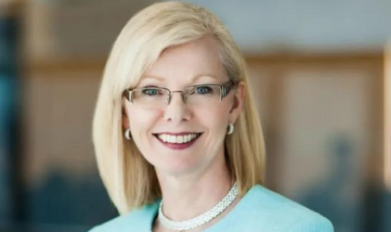
President & CEO, Halifax International Airport Authority, 2014 - Present


